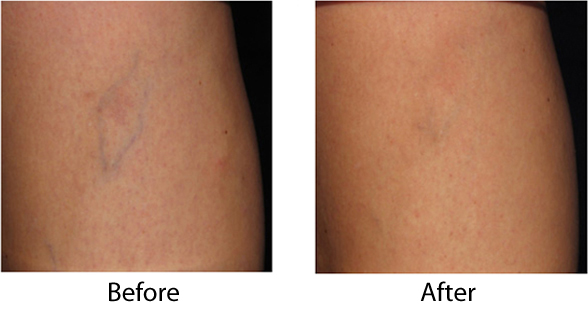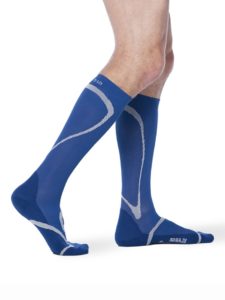What Are Reticular Veins?
Reticular veins are abnormal small dilated blue veins that form on the leg as we age (the blue vein on the right of the photo shown). They enlarge and dilate as a result of breakage of the vein’s internal valves and thinning of the walls of the leg veins located just beneath the skin surface. Reticular veins measure 1-3 mm in diameter, about the size of a tooth-pick. They typically form in clusters. They frequently develop behind the knees and on the ankles, although they can form anywhere on the leg. They are smaller than varicose veins (varicose veins are over 3 mm in diameter) and in most cases they do not bulge from the skin like varicose veins do. Most patients that have reticular veins also develop spider veins as well, which are even smaller unattractive veins that are purple or red in color and about the sizeof a thread (scattered veins on the photo shown). Reticular veins will cause spider veins on the legs to grow more aggressively and in darker, more-concentrated patches. Reticular veins are often referred to as “feeder veins” since they feed spider veins with abnormal blood flow and allow them to grow.

Reticular veins do not typically cause symptoms in most individuals, although they can be associated with some mild achiness. Reticular veins can sometime enlarge and become varicose veins with time. Reticular veins and varicose veins are genetically inherited but can also be caused by trauma to the leg. Most people that have reticular veins seek medical attention due to cosmetic concerns.
Treatment of Reticular Veins
There is only one effective treatment for reticular veins, which is called sclerotherapy. Sclerotherapy involved inserting a small needle into the veins and injecting a liquid medication into the veins that causes them to die and fade. Reticular veins tend to be too large and too deep to respond to surface laser or thermal treatments. Therefore the best option to cause these veins to fade away is to inject them with a medication, called a sclerosant. Polidocanol / Asclera is a commonly utilized medication used to treat reticular veins. Sotradecol is another agent that is also effective. Reticular veins can be treated with either a foam sclerosant (called foam sclerotherapy) or a more dilute form of sclerosant. When spider veins and reticular veins are both present on the legs, it is advised that both types of veins are treated simultaneously to achieve optimal results. Austin Vein Specialists are experts in the treatment of reticular veins.

Prevention of Reticular Veins
Reticular veins can often be prevented by taking some precautions if you know that you are genetically prone to develop them. If you have family members with reticular veins then you are much more likely to develop them yourself. One of the most useful methods of prevention of abnormal veins developing on your legs is to wear compression stockings to support your circulation. Medical compression stockings are more effective in prevention than over-the-counter stockings. This is because medical stockings are manufactured to deliver a more firm and uniform “graded” compression to the skin and leg veins. It is best to have the stockings custom measured by a healthcare professional or vein center in order to ensure the correct sizing, since they can a dozens of different sizes and lengths.
In addition to compression stockings, maintaining an active lifestyle and maintaining normal weight are critical in helping to slow down the development of reticular veins. Elevating your legs when at rest also helps to alleviate vein pressure in the leg and therefore will help prevent worsening of your leg veins.



